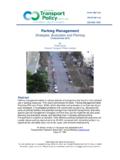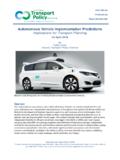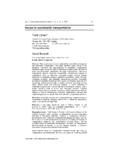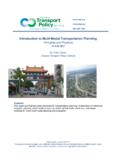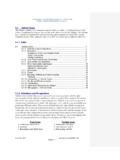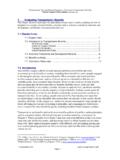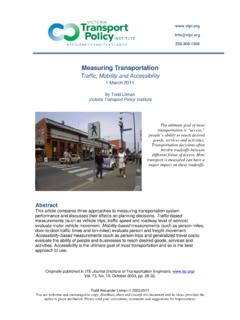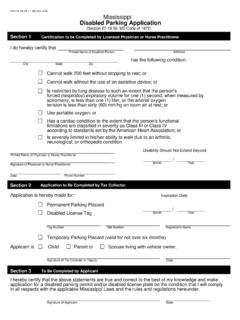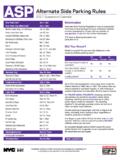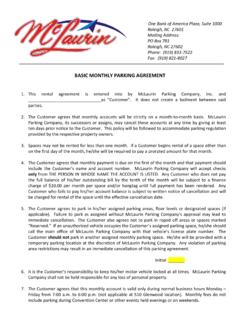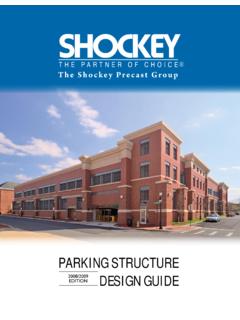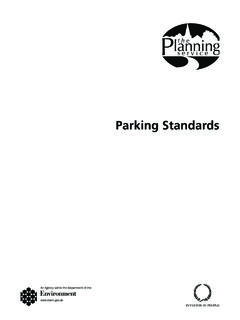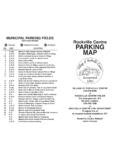Transcription of 5.4 Parking Costs 5.4.1 Chapter Index - vtpi.org
1 Transportation cost and Benefit Analysis II Parking Costs Victoria Transport Policy Institute ( ). Parking Costs This Chapter explores the Costs of providing Parking . It investigates the Costs of different types of Parking facilities, the number of spaces per vehicle, and the distribution of Parking Costs . Chapter Index Definitions .. 1. Discussion .. 2. Land Area and Value .. 2. Construction Costs .. 6. Operation and Maintenance .. 7. Environmental and Indirect 8. Distribution of Parking Costs .. 10. Amount of Land Devoted to Parking Facilities .. 10. Total Parking Costs .. 11. Parking Space Valuation .. 14. Other Estimates .. 16. Summary Table of Parking cost Estimates .. 16. General and Non-Resdential Studies .. 16. Residential .. 21. Stormwater Management .. 21. Variability .. 22. Equity and Efficiency Issues .. 22. Conclusions .. 24. Information 26. Definitions Parking Costs include Parking facility land, construction and operating Costs , plus indirect Costs such as stormwater management Costs .
2 There are various types of Parking facilities: On-street Parking consists of Parking lanes provided within public road rights-of-way. Off-street Parking are Parking facilities on their own land, not on road rights-of-way. Surface Parking refers to Parking lots directly on land. Structured Parking (also called parkades or ramps) are Parking facilities in or under multi- story buildings. Commercial Parking refers to Parking spaces rented to the general public for a profit. 19 July 2017 Page Transportation cost and Benefit Analysis II Parking Costs Victoria Transport Policy Institute ( ). Discussion Land Area and Value A typical Parking space is 8-10 feet ( meters) wide and 18-20 feet ( meter). long, totaling 144-200 square feet (13-19 sq. meters).1 Off-street Parking typically requires 250-350 square feet (25-35 square meters) per space, including access lanes and landscaping, allowing 125-175 spaces per acre (250-450 per hectare), depending on design.
3 Figure Land Required Per Parking Space Square Feet Per Parking Space 600. Landscaping 500. Driveway 400 Access Lane 300 Parking 200. 100. 0. On-Street Compact, Urban, Off- Full-size, Urban, Off- Full-size, suburban, street street off-street Land requirements per Parking space vary depending on type and size. Off-street spaces require driveways and access lanes. Landscaping typically adds 10-15% to Parking lot area. Land Costs can vary from thousands of dollars per acre in rural areas to millions of dollars per acre in central business districts (CBDs). Because Parking must be located near destinations, it often requires relatively high-value land. Parking facility land is sometimes considered to have little or no value. For example, building or campus managers sometimes consider land as free, and so only consider operating and maintenance expenses when calculating Parking Costs . But there is usually an opportunity cost to devoting land to Parking , since it could be used for buildings, landscaping, leased or sold.
4 Similarly, Parking lanes can be converted to traffic lanes, busways, bike lanes, landscaping, or additional sidewalk space. Some cities even convert Parking spaces to parklets (small sidewalk parks).2. 1 James Hunnicutt (1982), Parking , Loading, and Terminal Facilities, in Transportation and Traffic Engineering Handbook, Institute of Transportation Engineering/Prentice Hall, 1982, p. 651. 2 Pavement to Parks ( ) San Francico Parks Department. 19 July 2017 Page Transportation cost and Benefit Analysis II Parking Costs Victoria Transport Policy Institute ( ). Amount of Land Devoted to Parking Facilities3. Various studies have estimated the number of Parking spaces per vehicle and the total amount of land devoted to vehicle Parking in specific areas. Davis, et al. used detailed aerial photographs to estimate the number of Parking spaces in surface lots in Illinois, Indiana, Michigan, and Parking lots were identified as paved surfaces with stripes painted on the surface or where more than three cars were parked in an organized fashion, which excluded on-street and structured Parking spaces (other than the top floor if the structure has an open roof), and residential Parking spaces not in Parking lots.
5 They identified more than 43 million Parking spaces in these four states, which averages to off-street, non-residential spaces per vehicle. They estimate that these four states allocate 1,260 km2 (976 km2 lower bound to 1,745 km2 upper bound) of land to Parking lots. This accounts for approximately of urban land, with a higher proportion in more sprawled areas. Table Estimated Parking Spaces5. Type Scenario 1 Scenario 2 Scenario 3 Scenario 4 Scenario 5. On-street 35 92 180 150 1,100. Surface 36 520 520 610 790. Structure 34 110 110 84 120. Total 105 730 820 840 2,000. This table summarizes various estimates of Parking spaces. Chester, Horvath and Madanat estimate there are between 105 million and billion on- and off-street Parking spaces in the , based on the five scenarios summarized below, which indicates between to 8 Parking spaces per vehicle, as indicated in Table Chester, et al. (2015) estimate how Los Angeles County Parking supply changed from 1900 to 2010 and how this relates to changes in automobile travel and affects urban They estimate that in 2010 there were million Parking spaces, including million residential off-street, million nonresidential off-street, and million on- street spaces, as indicated in Figure For each motor vehicle they estimate there are spaces: residential off-street, nonresidential off-street, and on-street spaces, with the greatest density in the urban core and most new growth outside of the core.
6 In total, 14% of the County's incorporated land is used for Parking . 3 Todd Litman (2000), Transportation Land Valuation, VTPI ( ). 4 Am lie Y. Davis, Bryan C. Pijanowski, Kimberly D. Robinson and Paul B. Kidwell (2010), Estimating Parking Lot Footprints In The Upper Great Lakes Region Of The USA Landscape and Urban Planning, Vol. 96, Issue 2, 30 May 2010, Pages 68-77; at 5 Mikhail Chester, Arpad Horvath and Samer Madanat (2010), Parking Infrastructure: Energy, Emissions, And Automobile Life-Cycle Environmental Accounting, Environmental Research Letters, Vol. 5, No. 3; at ; also see 6 Mikhail Chester, et al. (2015), Parking Infrastructure: A Constraint on or Opportunity for Urban Redevelopment? A Study of Los Angeles County Parking Supply and Growth, Journal of the American Planning Association, Vol. 81, No. 4, pp. 268-286 (doi: ); at ; also see 19 July 2017 Page Transportation cost and Benefit Analysis II Parking Costs Victoria Transport Policy Institute ( ).
7 Figure Los Angeles County Parking Spaces, 1900-20107. The number of Parking spaces in Los Angeles has growth significantly during the last century. For each motor vehicle there are estimate to be spaces: residential off-street, nonresidential off-street, and on-street spaces Pijanowski found approximately three non-residential off-street Parking spaces per vehicle in Tippecanoe County, a typical rural Delucchi estimated 125 to 200. million non-residential, off-street Parking spaces in the US in 1991, to spaces per capita, or to per vehicle, as summarized below, but this estimate excluded some land use categories that generally include Parking such as religious institutions, car dealers and parks. Table Calculation of Land Area Devoted to Parking9. Nonresidential Offstreet Parking Low High Offstreet nonresidential Parking spaces (millions) 125 200. Fraction in lots as opposed to garages Size of Parking space (ft2) 150 150.
8 Total ground footprint of Parking lot/total Parking area Total ground footprint of garage/total Parking area Residential offstreet Parking Housing units with a garage or carport (million HUs) Average area to cars, per garage or carport (ft2) 167 225. Average area per residential driveway (ft2) 190 238. HUs with offstreet residential Parking other than own garage or carport (million HUs) Parking spaces per HU with offstreet Parking in lot, carport, or driveway Parking spaces per HU with other offstreet residential Parking in garage Fraction of other spaces in lots as opposed to garages Total ground footprint of Parking lot/total Parking area Total ground footprint of garage/ total Parking area Calculated total land area devoted to Parking cars (square miles) 2,146 3,064. 7 Chester, et al. (2015). 8 Bryan Pijanowski (2007), Parking Spaces Outnumber Drivers 3-to-1, Drive Pollution and Warming, Purdue University ( ); at 9 Mark Delucchi (1997), Annualized Social cost of Motor-Vehicle Use in the , 1990-1991, Vol.
9 6, Institute of Transport Studies ( ), Table 19 July 2017 Page Transportation cost and Benefit Analysis II Parking Costs Victoria Transport Policy Institute ( ). Akbari, Rose and Taha used high-resolution orthophtos of to estimate the area of various land-use types in Sacramento, California, summarized below and in table 1. Downtown and city center. Vegetation 30%, roofs 23% and paved surfaces (roads, Parking areas, and sidewalks) 41%. 2. Industrial. Vegetation covers 8 14% of the area, roofs 19 23%, and paved surfaces 29 44%. 3. Offices. 21% trees, 16% roofs, and 49% paved areas. 4. Commercial. Vegitation covers 5 20%, roofs 19 20%, and paved surfaces 44 68%. 5. Residential. Typically, vegetation covers about 36% of the area, roofs about 20%, and paved surfaces about 28%. Trees mostly shade streets, Parking lots, grass, and sidewalks. Table Calculated Surface-Area Percentages Tree Barren Grass Roof Road Sidewalk Parking Miscellaneous Cover Land Residential Commercial/service Industrial Transport/communications Industrial and commercial Mixed urban This table summarizes the surface area of various types of land uses in Sacramento, California.
10 McCahill and Garrick measured the relationship between vehicle travel and Parking land consumption in 12 They found that a 10 percentage point increase in automobile commute mode share is associated with an increases of more than square meters in Parking land consumption per capita. Overall, pavement covers about 35% of the surface area of most residential areas and 50 70% in most non-residential areas and summarized in Table Shoup calculates that, including on-street Parking , US cities have an average of about of eight Parking spaces for each This suggests that in typical urban areas there are probably, on average, at least three off- street Parking spaces per vehicle (one residential and two non-residential), plus numerous on-street spaces, the number of which is somewhat arbitrary since most suburban and rural roads have shoulders suitable for Parking not located near destinations. The number of Parking spaces per vehicle tends to be lower in urban areas where Parking is shared, and higher in suburban and rural areas where each destination supplies all its own Parking .
